Alchemical Plant Science – Alchemy and Natural Sciences Part 3
By Dennis Klocek 16 min read
In science today the driving force is to solve mysteries by innovation. Innovation is the clever manipulation of what is already known. As an effective research method for solving technical problems innovation has created wonders. But life evades technical solutions. Uncontrolled pandemics and complex climate change issues result from technical innovation being applied to issues in the life sciences.
The alchemists understood that when dealing with living systems it is better to let the mysteries gradually be revealed in their own way to the mind. Living systems evolve rapidly away from preformed solutions. Living things teach in a way that require the researcher to develop a disciplined imaginative capacity. This is to induce the hidden orders of things. Once a relationship in the natural order is revealed to a receptive, disciplined mind, hidden orders emerge in their own way.
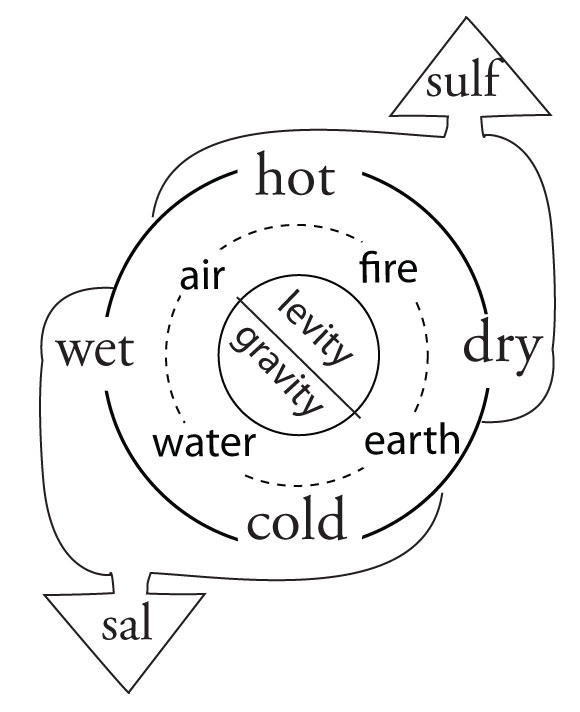
Hidden potentials are revealed to imaginative minds. Imagination fosters creativity needed to meet future challenges in living systems that are unprecedented. By contrast, technical innovation lures the mind into rearranging what has worked technically in the past. This approach is too brittle for the evasive and elusive, yet intelligent, order in natural wisdom.
The following article is designed to point out the hidden formative aspects of what contemporary science would see simply as predictable, disparate chemical reactions. The innovative chemistry of today is the corpse of the imaginative science of the alchemists. Their science was based on observation with no preconceptions. That was seen as the right approach to dealing with a mysterious living world.
Their living science has become a remarkably complex shell today. This death process has arisen out of the urge to apply technical solutions to rapidly evolving living systems. By studying life science through technical innovation science has become a maze of complex, abstract naming systems available only to the initiated.

By contrast the use of levity / gravity alchemical relationships can serve as the basis for a systematic, mandalic approach to sequencing natural phenomena. This develops a reliable pictorial based research system available to anyone. Pictorial thinking can support the idea that the macro(species) and micro (hormones) levels of plant development are based on resonant universal patterns inherent at all levels, and in all organisms. Revealing the universal resonant patterns in organisms at all levels opens the door to forming research ideas that can link plant growth to human physiology in profound ways.
The ever evolving challenges of human health can not be solved by technical thinking about the life sciences. The language of a living, growing plant forms, as well as the human embryo is inherently pictorial. The basis for this present work is to show pictorial patterns shared between the molecular diagrams used today to depict plant chemistry and the changes happening in a growing plant form itself . A Lewis diagram for the chlorophyll molecule is an image of a flowering plant.
These formal patterns are inherently resonant in all living things at all levels of inquiry. The hope is that this series of essays will enable a non-scientific person to see more deeply into how medicinal plants interact with the human organism. Those who grow and love plants will find this series challenging but hopefully rewarding of effort.
The alchemical method of analogy, a kind of pictorial or imaginative thinking process, flies in the face of the infinitely parsed out chemistry and physics of today but it is pictorially stimulating to the formation of analogs that can be constructed between plants and minerals or plants and animals or even plants and solar rhythms. The use of analogs points to potentials for creating synergistic healing substances that sciences based on genetics and molecular weights would overlook.

The alchemy of the four elements places earth and water in the sal pole due to their patterns of precipitation towards deposition of substances through the action of cold temperatures. Water, while relating to gravity and precipitation by being a manifest substance also has a relationship to levity. That is it lives in the clouds. Earth has much less relationship to levity and a deep relationship to gravity.
These kinds of polarities are analogs to the acid / base polarity or the electron donor / electron recipient polarity of redox reactions. Air and fire are in the levity pole of the four elements. Fire, being the most rarified has the least relation to gravity. But air, being weighable chemically, (in oxidation) reveals a slight relationship to gravity. In alchemy air would be considered an “ash” of fire. Water is an “ash” of air. Earth is an “ash” of water. When the water evaporates the earth falls out. Earth is brought into movement by the tempering of cold. Cold keeps the water in contact with the earth preventing the water from running into air. Air is tempered down by uniting with water in moisture formation. Air is tempered up by heat causing it to lose moisture and revert to a gas condition.
Fire is tempered down by air. Air still has some moisture so fire is tempered up when air dries out to create a condition of dryness. At that point fire loses levity and begins to produce ash out of the dry temperament. Fire that is tempered down by dryness produces earth (ash /salt). In these patterns cold, moist, hot and dry are the temperamental adjustments that are made between the more fixed elements of earth, water, air and fire.
These concepts undoubtedly appear hopelessly naive to chemical and physical science today. However, they provide a framework that allows the dynamic changes in the chemical structures of plants going into flower to be organized into a practical scheme for creating hormonal ferments for spray programs that enhance plant growth.

Carbon forms a scaffold or skeleton that other elements link to in the formation of more complex molecules. Carbon has the visible form of a mineral. Charcoal is a kind of dust or ash. Carbon has a strong gravity (salt) force that is the result of a previous strong levity(sulf) or burning state. Carbon is burnt out charcoal on the gravity side but, as basis for all organic chemistry, it is the scaffold of life and multiplicity on the levity side.
Molecularly carbon links to other things easily and it can also be connected to itself to provide more reactive potentials. The subscript signifiers that will follow are designed to depict the potential degree of levity or gravity forces present in a chemical element. Carbon, like oxygen has potentials for gravity but also for levity.
A diagram of these complexities of carbon can be formed using the subscript of capital G for a lot of gravity and small g for less gravity (or conversely more levity). Carbon seen in this way would be carbon or C(Gg). This represents carbon as a chemical gravity ash (G) and carbon also as the doorway to the mysteries of manifest life (g) through some form of interaction with levity. Since carbon in nature has great potential for forming double bonds that provide more reactive potentials, the subscript for carbon would reflect the potential to double. It would be C(GgGg). This signifies the strong gravity potentials brought to reactions by carbon. The reactive potentials of carbon to oxygen and hydrogen is the basis for carbohydrate formation.
Being a gas, oxygen naturally lives in the levity field. But oxygen is also very hungry for creating oxygen deposits in other substances. The attraction to form deposits (oxides) in multiple substances gives oxygen a strong connection to gravity. Most of the oxygen in the world is found in compounds and only a small amount is an actual air. This gives it a strong gravity function with a weak levity presence. As a designation for oxygen we could use O(Gl). Since it occurs as doubles the script would be O(GlGl).
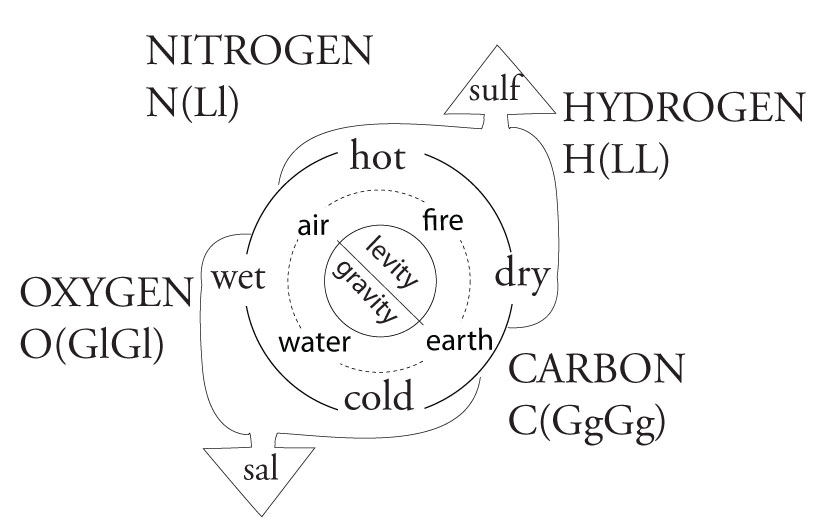
In the case of oxygen the capital G means it is strongly in the gravity pole through forming combinations and the lower case l points to it having fundamental levity by being a gas. The Gl designation shows that oxygen with strong gravity and weak levity is active in linking levity and gravity forces. Oxygen activity is the key to the oxidation/ reduction (redox) process.
Chemically in oxidation/ reduction (redox) reactions an element or a compound gains oxygen O(GlGl) from its environment while simultaneously causing the environment to lose or reduce that content of oxygen. Whatever the oxygen was linked to in the previous compound loses oxygen and then has a reduced oxygen content leading to more levity. The oxidizing compound gains gravity by combining with the released oxygen. The reducing compound loses gravity to the oxidizing compound as it moves towards levity and combustion.
Combustion releases levity forces of warmth and light. In the reduced oxygen state the oxygen donor gains forces of levity and loses forces of gravity. In combustion we see visible fire emerge as the compound rarifies into invisibility in air, light and warmth. The gain of oxygen in oxidation makes compounds more reactive to forming combinations with other compounds. Gaining oxygen makes simple compounds more complex. More complex molecules are more reactive with their environment through the redox action.
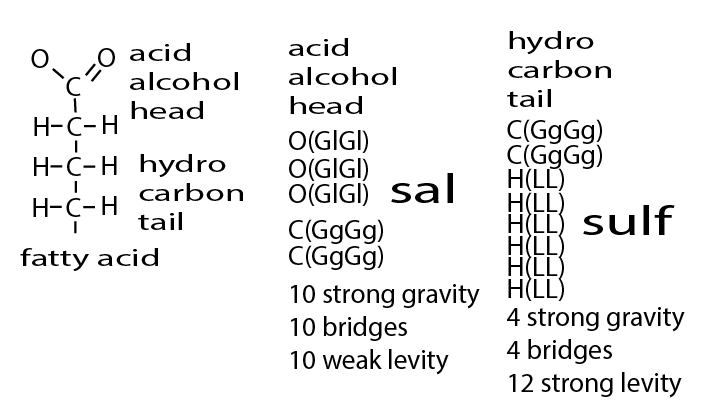
The image shows the components of a basic organic building block, the fatty acid. This form is fundamental to the development of oils and resins in plants. It is used here to illustrate the value of using subscripts of levity and gravity as imaginations of how plant medicines interact with the nerve (gravity) and blood(levity) polarity in human beings.
The relationships between plants and human health can be effectively researched from this perspective.
On the left is a chemical diagram of a fatty acid molecule. It has a head pole composed of an ester, that is a union of an acid and an alcohol. Esters are related to the gravity or salt pole and to water solubility. The hydrocarbon tail is related to the warmth sequestering forces of oils and to their water avoidance. Water solubility and oil solubility, that guide the functions of cell membranes, are both needed for health.
To the right is a breakdown of the gravity and levity contributions to this molecule. The water soluble acids and alcohols in the head portion are combinations of oxygen and carbon. Multiple bonds of oxygen O(GlGl) and carbon C(GgGg) are in the sal pole of gravity. By proportions of levity and gravity this “short chain” fatty acid has ten strong gravity units and ten weak levity units favoring gravity and water solubility. Further solubility in water is given by ten bridges (reactive potentials) composed of lesser gravity / levity qualities. The overall sum of levity / gravity forces in the acid suggests the dominance of gravity that allows for reactive or solvent potentials in the head portion of the molecule.

By contrast, the hydrocarbon tail is alchemically in the levity or sulf pole being composed of carbon united to dominant hydrogen. There are four strong gravity units from carbon, four bridges (reactive potentials) and twelve strong levity units from abundant hydrogen. This suggests the dominance of levity in a substance with moderate bridging potentials. Through reduced carbon content and no oxygen content, this molecule has much less gravity force. This substance avoids uniting with gravity potentials. It is water avoiding. The water soluble ring and oil soluble fatty tail of this fundamental molecule has a form resonant to the molecular formation of the important plant substance chlorophyll.
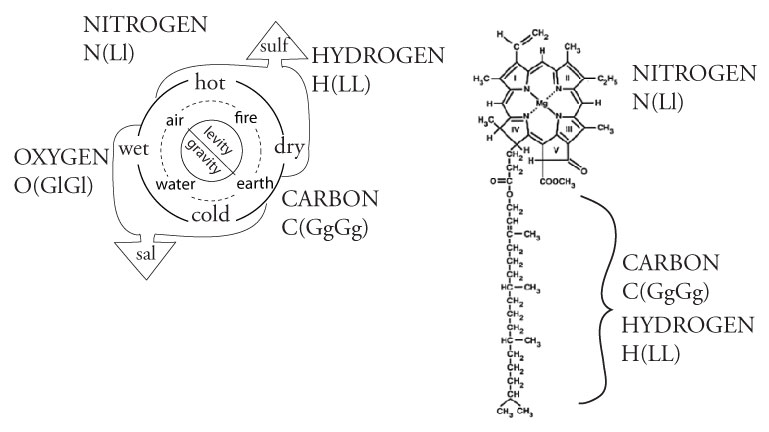
In the formation of chlorophyll oxygen O(GlGl) and nitrogen N(Ll ) combine. Nitrogen gas is the largest component of the air we breathe. This gives it a strong levity signature N(L). But nitrogen is also very active in combinations throughout nature as part of the light-absorbing “light antenna” of the chlorophyll pigment molecule. This brings it closer to the gravity or deposition pole. That means that nitrogen as a gas has a strong levity aspect and a weak levity aspect. We could write nitrogen as N(Ll). In the chlorophyll molecule the nitrogen that makes up the head portion forms amino acids that are water soluble. These acids link to the water soluble salts of magnesium. Together they form a reaction center for inducing light to come down into substance. They form the life supporting pigment that is found everywhere in all plants, at all times.
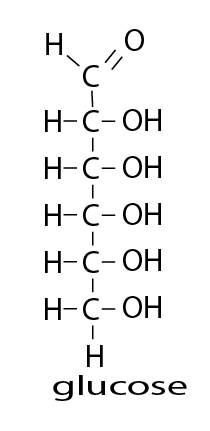
The use of the gravity/levity subscripts is a kind of shorthand. A subscript of (GG) would designate a strong gravity force incapable of easy interaction with levity. (Gg) would designate a strong gravity force coupled to a weak gravity force. That subscript depicts reactive potentials leading to deposition since both qualities are in the gravity pole. C(GgGg) is the signature of strong double bonding gravity potentials of carbon. (Gl) as a subscript indicates strong gravity coupled to weak levity. This is an analog of reactive potential leading to combinations moving towards combustion since the weak levity force is a stronger move towards levity than a weak gravity force. O(Gl) designates oxygen with a strong gravity force and a weak levity force.
O(GlGl) is the signature of oxygen that always occurs in pairs. A subscript with two capital letters (GL) would signify a state where levity and gravity would be in a stand off. Being polar there would be no common vector to instigate change. Something else would be needed to create reactivity. The small letters of a subscript (gl) signify a potential for reactivity. Small letters point towards the substance having a reactive bridging capacity. Using these subscripts helps to identify compounds with potentials to be more reactive in combinations either towards deposition or towards combustion. These kinds of subtle levity / gravity relationships are the very essence of the interactions of plant growth regulators (PGR) in organic chemistry.
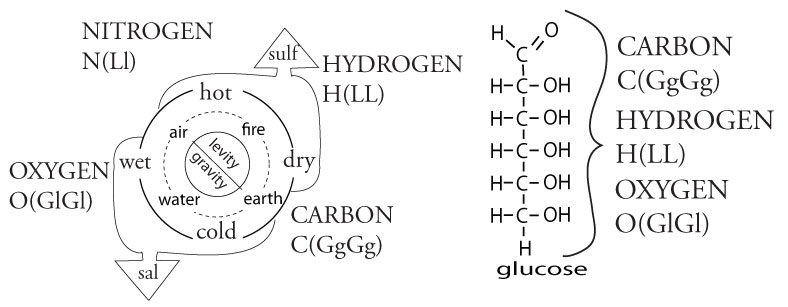
The use of subscripts is a shorthand useful when trying to understand the fundamentals of water soluble and oil soluble substances that are analogous to plant forms and medicinal properties. Carbohydrates (glucose is shown) are water soluble substances. Water has hydrogen with strong levity H(LL) combined with variable gravity from the double oxygen content (GlGl). In subscript, water would be H(LL)/O(GlGl). The split of levity and gravity in water shows reactive potentials for combination in the gravity pole through the oxygen but with a definite tendency to move easily into the levity state. This allows water to stay on the earth when cold and easily rarify into levity with slight temperature warming.

The patterns revealed by the levity / gravity subscripts accurately describe the temperaments (cold and moist) of water. Glucose is a carbohydrate composed of carbon C(GgGg), oxygen O(GlGl) and hydrogen H(LL). When carbohydrates form, oxygen O(GlGl) brings a strong/ weak gravity gesture capable of making connections to form sugars. In carbohydrate formation the reactive oxygen O(GlGl) mediates the gravity laden carbon C(GgGg) to interact with the levity laden hydrogen H(LL). The carbohydrate formula C6H12O6 shows this balanced pattern with carbon C(GgGg), hydrogen H(LL), oxygen O(GlGl) in a ratio of 1:2:1.
The gravity force of the oxygen combined with the gravity force of the carbon contributes towards the development of a reactive oxidation process for creating many combinations with other things. The weak levity of oxygen and the strong levity of hydrogen contribute to the reduction, combustion or burning aspect of redox. Oxidation is a kind of burning that draws in the gravity force of oxygen O(GlGl) and releases the levity forces of hydrogen H(LL).
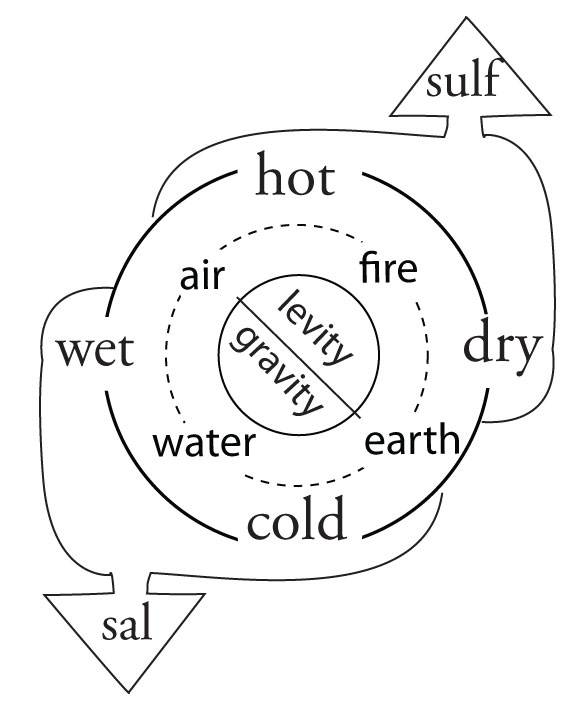
Burning results in what an alchemist would call an “ash” such as carbon C(GgGg) with its split of strong gravity and weak gravity. Chemically in an oxidation process oxygen is precipitated out of the reducing environment. Oxygen in this way can be viewed alchemically as an “ash” that is deposited in the oxidizing compound as the reducing compound burns and releases levity. The ash contains the salt that attracted water.
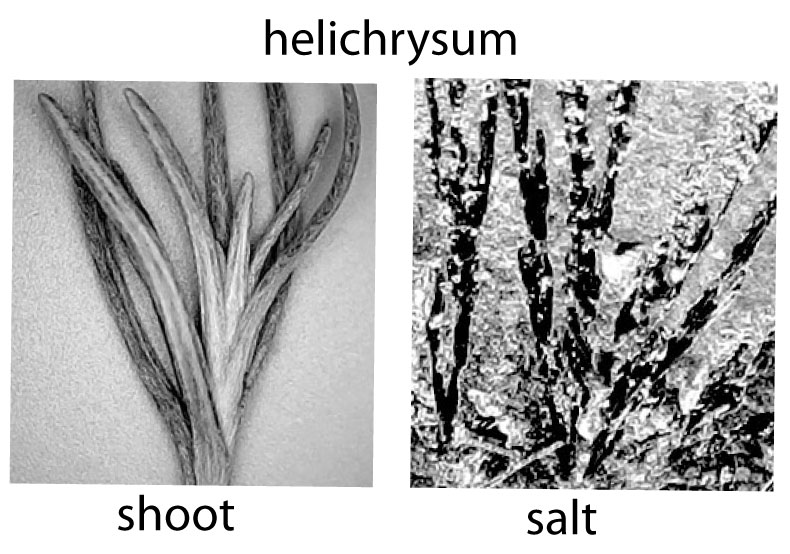
The image shows a shoot of helichrysum and the salt taken from its ash. The salt pattern resembles the shoot formation. In plant alchemy the ash of a burnt (oxidized) plant contains a metal salt of potassium plus carbon that forms potassium carbonate salt. That salt is active in the water economy of the sap in the growth phase. The salt attracts water in the soil and is key to its movement in the sap. If the plant is dried and incinerated to ash and the ash is placed in water, the potassium and carbon that originally moved the sap through the tissues will be crystallized (gravity) as the water evaporates.
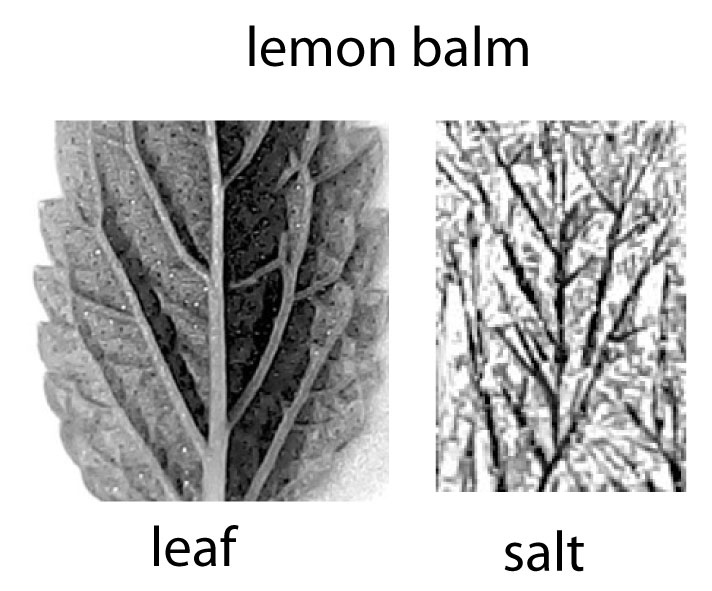
The same thing happens in the soil solution when the water taken up by plant roots contains the soluble potassium salt that relates to the soil carbon. This dynamic of a salt rising with water into levity (solution) and then falling into gravity (potassium/calcium carbonate) makes the invisible dynamic of the plant species visible in the particular form of the plant. The salts that grow the plant resemble the form of the plant. This image shows a leaf vein pattern of lemon balm and the salt taken from the burned leaves. The forms are very similar. The flow of metabolites in sap loses its dynamism as the substances are deposited. When this happens, the visible plant appears.
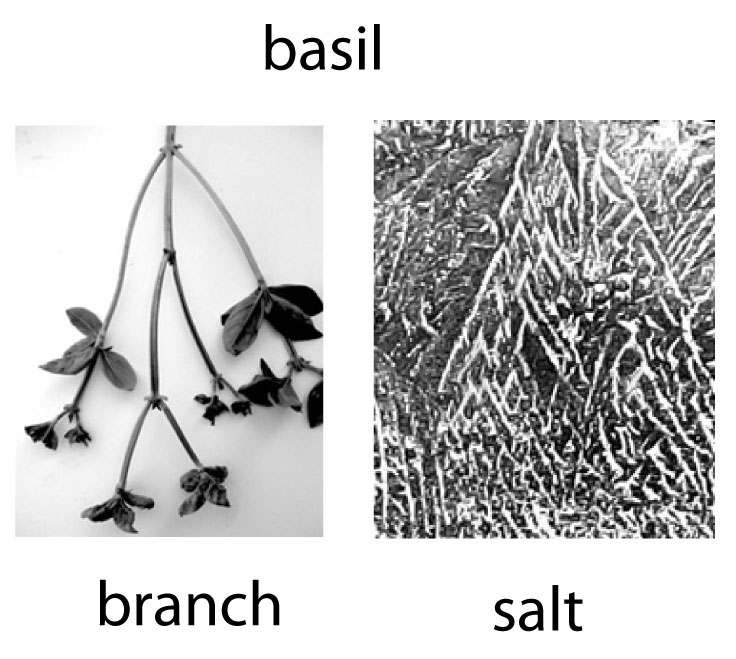
The visible plant seen this way is the visible wake of the dying dynamic of the invisible plant. This next image shows the branching pattern of basil with a close similarity to its salt structure. The gravity force that induces salt in sap fixes metals, hormones and enzymes into manifest substances. The whole process of combinations of minerals (gravity) and gasses (levity) to create more complex compounds are rhythms of precipitation (gravity) and rarefaction (levity) that guide plant saps during active growth.
Alchemically, the cycles of dissolution and precipitation of salts in sap is the salt or sal pole. The salt pole is the oxygenated pole in plant chemistry. It includes soluble things as acids, alcohols, phenols, sugars and of course the oxides of soluble metal salts. The oxygenated compounds are reactive and are the basis for anabolic growth in the expansion into vegetation. Oxygenated compounds also contribute to the later catabolic metabolism (combustion) resulting in the formation of flower and seed and their oils. In the language of form the visible growth of a plant is an analog of the invisible redox processes that formed it.
The integration of oxygen to form more complex structures is a form of deposition that alchemically is a sal gesture. Sal processes, representing a kind of accumulative or agglutinating impulse often serve as foundations for reactions. The more complex oxygenated substances are generally more reactive. The reactivity represents the influence of gravity to form the basis for a subsequent levity state.
Oxygen reactivity produces the well known corrosive ROS (reactive oxygen species) that nutritionists warn about. The deposition of oxygen incites inflammatory response. In inflammation, reactivity becomes too much and ash is produced that falls out of the sulf condition into the production of ash/salts. The salts are irritating and attract fluids for healing. The fluids rushing to the site lift the irritating salts into levity states so that they can be excreted.

Dennis Klocek
Dennis Klocek, MFA, is co-founder of the Coros Institute, an internationally renowned lecturer, and teacher. He is the author of nine books, including the newly released Colors of the Soul; Esoteric Physiology and also Sacred Agriculture: The Alchemy of Biodynamics. He regularly shares his alchemical, spiritual, and scientific insights at soilsoulandspirit.com.
Similar Writings
Video: Seedling to Table – Growing Cabbage, Making Kraut
Learn the tricks and tips from Dennis Klocek, master gardener, for how to grow, harvest, and process cabbage into sauerkraut.